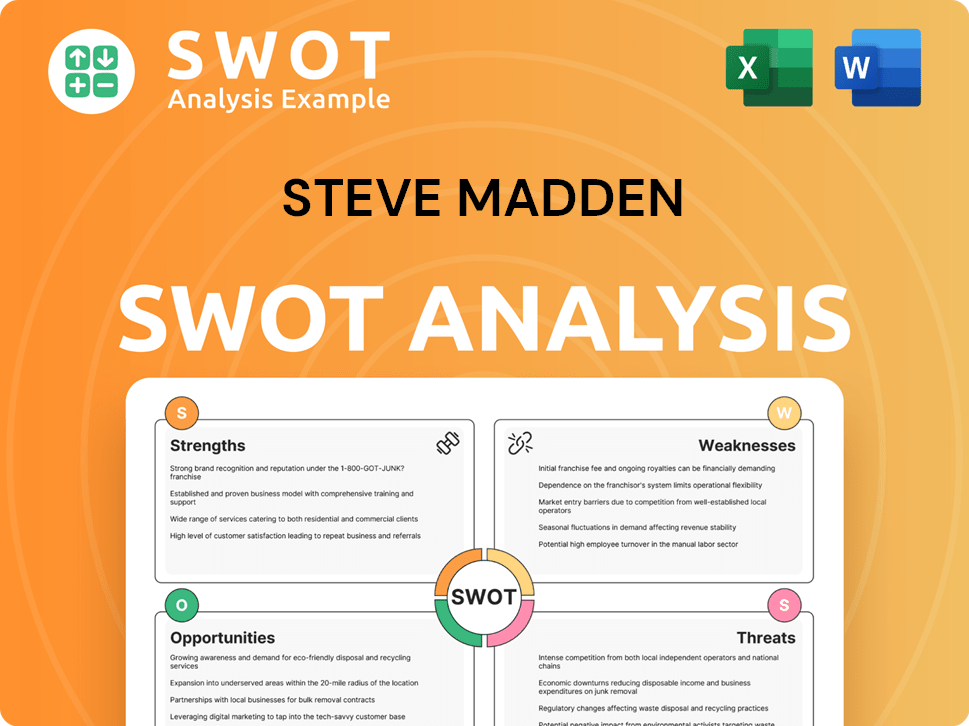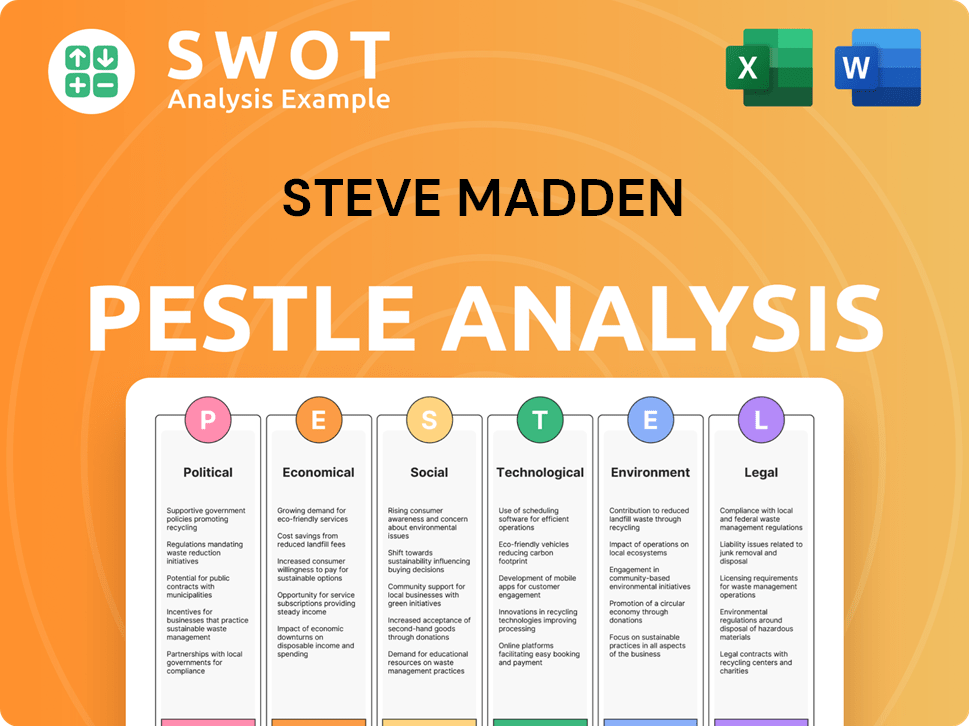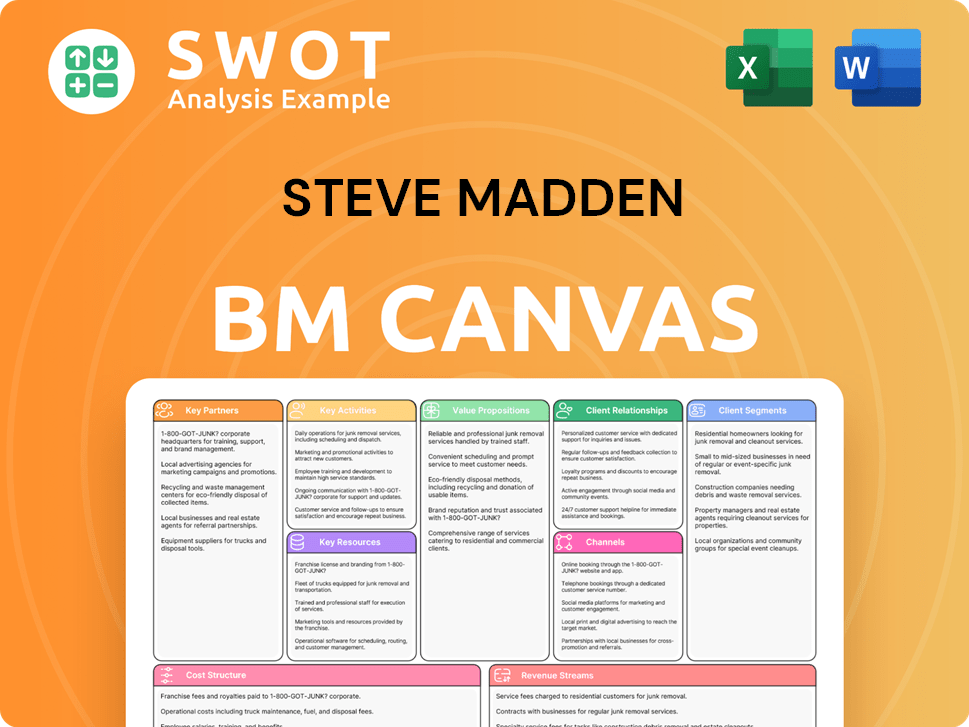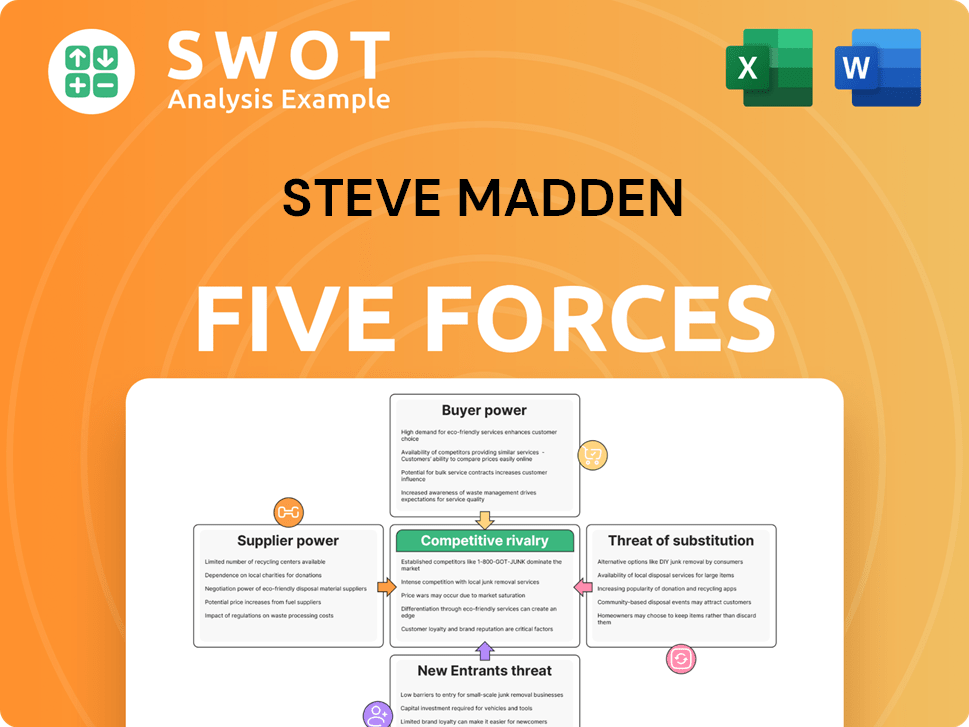Steve Madden Bundle
Who Buys Steve Madden?
In the fast-paced world of fashion, understanding your customer is paramount. For Steve Madden, this means a deep dive into its customer demographics and target market. From its humble beginnings in 1990, the brand has evolved, adapting to the ever-changing landscape of consumer preferences. A strong understanding of the Steve Madden SWOT Analysis is key to understanding the brand's customer base.

This exploration will uncover the specifics of the Steve Madden target market, providing insights into the Steve Madden audience, including their age range, income levels, and fashion preferences. We will delve into the buying behavior analysis of Steve Madden consumers, examining their lifestyles, online customer base, and retail customer analysis. This analysis of Steve Madden's customer profile will reveal how the brand positions itself to capture its ideal customer profile and maintain its success in the competitive fashion industry, focusing on customer demographics and brand positioning.
Who Are Steve Madden’s Main Customers?
Understanding the Steve Madden's primary customer segments is crucial for grasping its market strategy. The company primarily focuses on the business-to-consumer (B2C) market, targeting individuals who are keen on staying updated with current fashion trends. This customer base is characterized by a desire for stylish yet affordable products, making the brand accessible to a broad audience.
The core demographic of the Steve Madden audience traditionally leans towards younger women, typically aged between 18 and 40. This group is known for being fashion-conscious and often influenced by social media and celebrity styles. These consumers usually have mid-range income levels, which includes students and young professionals, who prioritize aesthetic appeal and contemporary designs in their purchasing decisions.
While footwear remains a cornerstone, the brand has expanded into accessories and apparel. This strategic move has allowed the company to attract a more diverse customer base. Recent financial reports highlight acquisitions like Dolce Vita and Greats, indicating a move to capture different aesthetic preferences and potentially higher income brackets. This diversification is part of a broader strategy to ensure continued growth by tapping into new customer segments while maintaining its core identity.
The Steve Madden target market primarily consists of women aged 18-40, who are fashion-forward and influenced by trends. They are typically in the mid-income bracket, including students and young professionals. The brand's expansion into accessories and apparel broadens its appeal.
The Steve Madden customer profile often includes individuals with mid-range income levels. Their lifestyle is characterized by an interest in current fashion trends and a desire for stylish products. They often rely on social media and celebrity influence for their fashion choices.
The brand segments its market based on age, income, and fashion preferences. This approach allows for targeted marketing and product development. The expansion into new product categories helps to reach different segments.
Steve Madden positions itself as a provider of trendy and accessible fashion. This strategy attracts a broad customer base. The brand's focus on current styles and affordable pricing has contributed to its success.
The Steve Madden consumers are fashion-conscious individuals, primarily women aged 18-40. They are influenced by social media and celebrity styles, with mid-range income levels. The brand's appeal extends to those seeking trendy and affordable fashion options.
- Age Range: Primarily 18-40 years old.
- Income: Mid-range, including students and young professionals.
- Fashion Preferences: Current trends, influenced by social media.
- Buying Behavior: Prioritizes aesthetic appeal and contemporary design.
Steve Madden SWOT Analysis
- Complete SWOT Breakdown
- Fully Customizable
- Editable in Excel & Word
- Professional Formatting
- Investor-Ready Format

What Do Steve Madden’s Customers Want?
Understanding the needs and preferences of the company's customers is key to its success. The company's appeal lies in its ability to offer trendy products that resonate with current fashion trends, allowing customers to express their personal style. This approach, combined with accessible price points, helps the company maintain a strong position in the competitive fashion market.
The company's customers are drawn to the brand for a variety of reasons, including the desire for stylish items without the high cost often associated with fashion. This customer base, which includes a diverse range of individuals, from young adults to fashion-conscious professionals, seeks footwear and accessories that are both fashionable and versatile. The brand's marketing strategies, which often feature diverse models and lifestyle imagery, are designed to connect with this broad target market.
The company's success is also influenced by its understanding of how customers make purchasing decisions. Factors such as design, perceived quality, comfort, and price play crucial roles. Social media, influencer marketing, and celebrity endorsements significantly influence buying behavior, highlighting the importance of brand perception and desirability. For more insights into the company's structure, consider reading about the Owners & Shareholders of Steve Madden.
The company's customers, or the 'Steve Madden consumers,' prioritize several key aspects when making purchasing decisions. They seek products that are on-trend and allow for self-expression, aligning with the latest fashion sensibilities. The brand's ability to provide this while maintaining accessible price points is a significant factor in its appeal.
- Fashion-Forward Designs: Customers want stylish footwear and accessories that reflect current trends.
- Versatility: Products that can be worn for various occasions, from casual to formal, are highly valued.
- Price and Value: The brand offers fashionable items at price points that are accessible to a broad customer base.
- Brand Influence: Social media, influencer marketing, and celebrity endorsements significantly shape purchasing decisions.
Steve Madden PESTLE Analysis
- Covers All 6 PESTLE Categories
- No Research Needed – Save Hours of Work
- Built by Experts, Trusted by Consultants
- Instant Download, Ready to Use
- 100% Editable, Fully Customizable

Where does Steve Madden operate?
The geographical market presence of the company is extensive, with a strong foothold in several key regions. The United States serves as a primary market, where the brand has established a robust presence through its retail stores, e-commerce platforms, and wholesale distribution channels. This has allowed the company to build a strong customer base and brand recognition.
Beyond the U.S., the company has a significant presence in Canada, the United Kingdom, and Mexico. These markets contribute substantially to the overall revenue, indicating the brand's appeal and market penetration in these areas. The company strategically adapts its offerings and marketing strategies to suit local preferences and buying power.
The company also explores emerging markets, analyzing fashion trends, economic indicators, and consumer spending habits to identify new growth opportunities. Strategic partnerships and collaborations are also employed to strengthen its presence in diverse markets. For more insights into the brand's financial strategies, you can explore the Revenue Streams & Business Model of Steve Madden.
The company's geographical footprint includes a strong presence in North America, Europe, and parts of Asia. The United States remains a core market, with extensive retail and online presence.
The company tailors its offerings and marketing to suit local preferences. This includes adjusting inventory and promotional efforts based on regional style preferences and consumer behavior.
The company engages in partnerships to strengthen its presence in diverse markets. These collaborations help expand the brand's reach and appeal to different customer segments.
Market entry strategies are driven by analysis of fashion trends, economic indicators, and consumer spending habits. This data-driven approach helps identify and capitalize on new opportunities.
Steve Madden Business Model Canvas
- Complete 9-Block Business Model Canvas
- Effortlessly Communicate Your Business Strategy
- Investor-Ready BMC Format
- 100% Editable and Customizable
- Clear and Structured Layout

How Does Steve Madden Win & Keep Customers?
The company's customer acquisition and retention strategies are multifaceted, employing a blend of digital and traditional marketing approaches. Digital marketing is heavily utilized, including social media campaigns, influencer collaborations, and targeted online advertising. Traditional methods, such as in-store promotions and placements in fashion magazines, also play a significant role in reaching the target audience.
Sales tactics include seasonal sales, limited-time offers, and collaborations that generate excitement and encourage immediate purchases. Customer retention is fostered through consistent engagement, personalized product recommendations based on past purchases, and excellent after-sales service. Customer data and CRM systems are crucial for segmenting customers and delivering relevant marketing messages.
Successful acquisition campaigns often go viral due to their trendy nature, while retention efforts focus on maintaining brand loyalty and encouraging repeat purchases. The company continuously adapts its strategies based on market trends and consumer behavior, impacting customer lifetime value and reducing churn.
The company leverages digital marketing extensively. This includes social media campaigns on platforms like Instagram and TikTok to engage with the Steve Madden brand's target market. Influencer collaborations with fashion bloggers and celebrities are also key.
Traditional marketing channels, such as in-store promotions and strategic placements in fashion magazines, are still used. These methods help to reach customers who may not be as active online. Seasonal sales events and limited-time offers drive immediate purchases.
Sales tactics often involve seasonal sales events and limited-time offers to generate immediate purchases. Collaborations also create buzz and drive sales. These promotions are designed to attract the Steve Madden consumers and encourage buying.
Customer data and CRM systems are essential for segmenting customers and ensuring that marketing messages are relevant and timely. This helps in personalizing the customer experience and improving engagement. This is critical for understanding the Steve Madden customer profile.
The company focuses on maintaining brand affinity and encouraging repeat purchases through consistent engagement and excellent after-sales service. The company's ability to adapt its strategies based on market trends and consumer behavior is key to impacting customer lifetime value and reducing churn in the fast-paced fashion industry. The company's approach to understanding its Steve Madden audience is essential for its continued success in the market.
Active presence on platforms like Instagram and TikTok to engage with the Steve Madden target market. Regular content updates and interactive campaigns are used to increase brand visibility. This includes contests, polls, and user-generated content to boost engagement.
Collaborations with fashion bloggers and celebrities to promote new collections and increase brand awareness. Influencers create content showcasing the brand's products to their followers. This strategy helps to reach a wider audience and build credibility.
Utilizing email marketing to engage with existing customers and promote new arrivals and sales. Personalized emails based on past purchases and browsing history are common. This helps in driving repeat purchases and building customer loyalty.
In-store promotions and events to drive foot traffic and sales. This includes special offers, discounts, and exclusive previews of new collections. These promotions are designed to attract customers to physical retail locations.
Strategic placements in fashion magazines to increase brand visibility. This includes advertisements and editorial features showcasing the brand's products. This helps in reaching a wider audience and building brand image.
Personalized product recommendations based on past purchases to encourage repeat purchases. Excellent after-sales service, including easy returns and responsive customer support. These efforts help to foster customer loyalty and increase customer lifetime value.
Steve Madden Porter's Five Forces Analysis
- Covers All 5 Competitive Forces in Detail
- Structured for Consultants, Students, and Founders
- 100% Editable in Microsoft Word & Excel
- Instant Digital Download – Use Immediately
- Compatible with Mac & PC – Fully Unlocked

Related Blogs
- What are Mission Vision & Core Values of Steve Madden Company?
- What is Competitive Landscape of Steve Madden Company?
- What is Growth Strategy and Future Prospects of Steve Madden Company?
- How Does Steve Madden Company Work?
- What is Sales and Marketing Strategy of Steve Madden Company?
- What is Brief History of Steve Madden Company?
- Who Owns Steve Madden Company?
Disclaimer
All information, articles, and product details provided on this website are for general informational and educational purposes only. We do not claim any ownership over, nor do we intend to infringe upon, any trademarks, copyrights, logos, brand names, or other intellectual property mentioned or depicted on this site. Such intellectual property remains the property of its respective owners, and any references here are made solely for identification or informational purposes, without implying any affiliation, endorsement, or partnership.
We make no representations or warranties, express or implied, regarding the accuracy, completeness, or suitability of any content or products presented. Nothing on this website should be construed as legal, tax, investment, financial, medical, or other professional advice. In addition, no part of this site—including articles or product references—constitutes a solicitation, recommendation, endorsement, advertisement, or offer to buy or sell any securities, franchises, or other financial instruments, particularly in jurisdictions where such activity would be unlawful.
All content is of a general nature and may not address the specific circumstances of any individual or entity. It is not a substitute for professional advice or services. Any actions you take based on the information provided here are strictly at your own risk. You accept full responsibility for any decisions or outcomes arising from your use of this website and agree to release us from any liability in connection with your use of, or reliance upon, the content or products found herein.